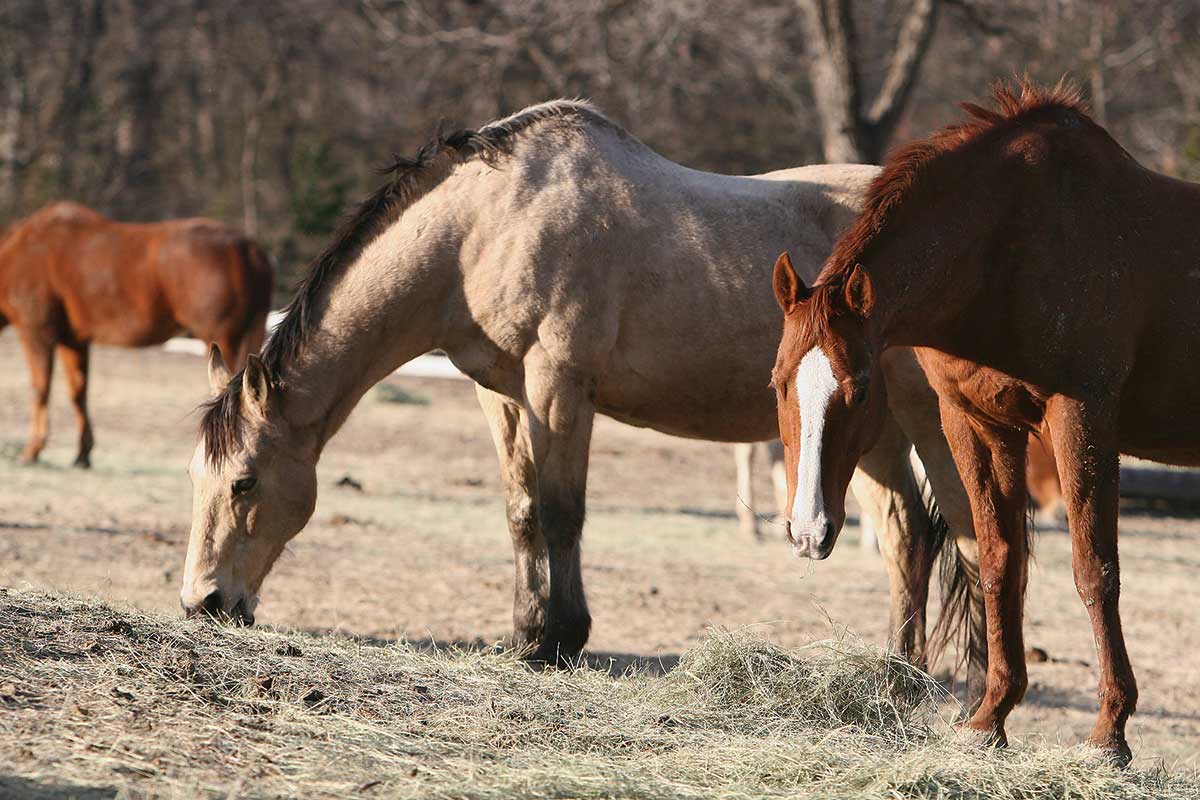These days, commercial feeds can contain a lot more than just alfalfa meal and cereal grains, and looking at feed-tag ingredients lists can be confusing. We asked equine nutritionist Clair Thunes, PhD, whose Sacramento-based Summit Equine Nutrition (summit-equine.com) advises clients throughout the U.S. and Canada, to give us a breakdown of modern horse feed ingredients.

Here’s what she told us.
Feed Option 1: Complex Carbs
These are one of the three main sources of energy in horse feeds. (The other two are nonstructural carbohydrates [simple carbs/starch] and fats.) Complex carbs, which require bacterial fermentation in the horse’s hindgut in order to be broken down, typically come from common hays such as alfalfa, grain hay (such as oat), and grass hay (such as Bermuda), or sometimes from less-common forages such as soybean hay. Other sources of complex carbs are highly fermentable “super” fibers such as beet pulp and soybean hulls. Super fibers provide a greater quantity of calories than typical forages and are useful where calories are needed but starch must be limited.
Feed Option 2: Simple Carbs/Starch
These are typically provided by traditional grains such as barley, corn, and oats, as well as molasses?a customary ingredient in sweet feeds. Some feed manufacturers may use the collective term “grain products” on their ingredients list, which can include any of these grains in various forms plus others such as wheat and rice.
Feed Option 3: Fats
Fat tends to be highly digestible and contains two and a quarter times more energy than an equal weight of carbohydrate. It also helps reduce the dustiness of feeds and aids in the absorption of fat-soluble nutrients, such as vitamin E. Sources of fat include vegetable, soybean, and corn oils, all of which supply energy only?no protein or minerals. Rice bran (about 20-percent fat) is another popular source.
Levels of fat in horse feeds have increased in recent years as manufacturers have sought to decrease energy from starch. With the growing awareness of fatty-acid balance in the diet, some feed companies are moving away from using corn oil as a fat source (as it’s high in omega-6 fatty acids) and relying more on soybean oil (which has a slightly higher omega-3 count). Some companies also are beginning to add omega-3 fatty acids from flax and even fish oil to some of their higher-end products.
One complication of fat in horse feeds is that it makes the resulting product harder to form into pellets. For this reason, high-fat feeds are often textured, or a mix of pellets and other ingredients, such as beet pulp. In these instances, the fat may be applied to the feed toward the end of processing, which can cause the feed to look “wet.” Traditionally, such an appearance has been caused by molasses, thus can create concern in the eyes of buyers trying to avoid simple carbs. So always check the feed tag to determine if a wet appearance is likely the result of fat or molasses in the product.
Feed Option 4: Protein
Many different sources of protein are found in horse feed, and they’re not all of equal quality. Protein consists of amino acids, which fall into two types: “essential,” which must be provided in the diet, and “non-essential,” which may be created by the horse’s own system. Protein quality is judged by the proportion of essential amino acids that the protein source provides.
High-quality protein sources include milk proteins (dried whey) and by-products of oil production from oil seeds such as soybeans. All these are high in the essential amino acid lysine.
Other sources of protein include linseed and canola meals. Sometimes feed companies add amino acids individually, and you may see these listed on the tag (for example, l-lysine monohydrochloride).
Feed Option 5: Minerals/Vitamins
These are included in commercial feeds to ensure that the deficiencies and imbalances typically found in the forages consumed by most horses are corrected. Macrominerals (required in gram amounts) may include calcium, phosphorus, magnesium, sodium, potassium, and chloride.
Trace minerals (required in milligram amounts) include copper, iron, zinc, manganese, selenium, and iodine.
Vitamins include A, D, and E, plus several of the B vitamins. Natural vitamin E (d-alpha tocopherol) is most absorbable.
Feed Option 6: Digestive Aids
These ingredients, which aid in the utilization of feed by supporting the horse’s gut-bacteria populations, have become more common in feeds. They include various enzymes and yeast cultures, as well as the extracts and products of specific bacterial populations, such as lactobacillusacidophilus.
Feed Option 7: Other
These include preservatives (propionic acid), flavorings (anethose, fenugreek seed, yucca), stabilizers (lecithin), and pelleting agents (glycerin).
A Word about Horse Feed By-Products
By-products, now increasingly common in horse feeds, sometimes cause concern among horse owners. The term conjures up images of mill leftovers and waste, but many by-product ingredients are nutritious and have been accepted for years.
For example, wheat bran, a staple of feed rooms for decades, is a by-product of wheat-flour processing. Beet pulp, which many horse owners love to feed, is left over after the sugar is extracted from sugar beets.
Newer and less-well-understood by-products include wheat mill run and wheat middlings. These are popular because they “pellet” well and allow performance diets to maintain a high caloric intake while reducing starch. Other grains have a starch content that’s often over 45 percent; by contrast, wheat middling and wheat mill run provide a comparable amount of digestible energy but with a starch content of only about 25 percent.






